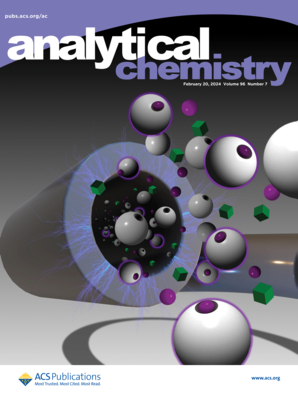Enhancing Thermodynamic and Kinetic Performance of Microfluidic Interface-Based Circulating Fetal Cell Isolation for Noninvasive Prenatal Testing
IF 6.7
1区 化学
Q1 CHEMISTRY, ANALYTICAL
引用次数: 0
Abstract
Multivalent strategies have been widely applied in the microfluidic interface to boost the capture efficiency of target cells. However, achieving a balance between binding kinetics and thermodynamics in existing multivalent affinity interfaces remains challenging. Here, we propose a synergistic Aptamer-nanobody hetero-Multivalency Programmable magnetic fluid microfluidic chip (AMP-chip) which utilizes the combined advantages of ligands to enhance both thermodynamic and kinetic properties of the capture interface. The AMP-chip integrates two distinct noninterfering recognition molecules: one with high affinity and another with rapid binding capability, both of which are assembled onto nanomagnetic beads. This integration achieves intermolecular complementarity, effectively enhancing the binding kinetics and thermodynamic stability. We chose mutually noninterfering CD71 recognition targets, a high-affinity nanobody (NB) and a rapid-binding aptamer (XQ 2d), and fully utilized the respective advantages of these ligands to facilitate rapid and tight recognition of the CD71 receptor on target cells. By integrating a herringbone microarray into an AMP-chip to further increase the cell–ligand interaction, we significantly improved the sensitivity and accuracy of circulating nucleated red blood cell (cNRBC) isolation from the peripheral blood mononuclear cells (PBMCs) of pregnant women. Additionally, the ligands were primarily fixed to the chip by magnetic force without chemical bonding, enabling nondestructive cell release and preserving high cell viability for subsequent molecular analyses. Overall, this approach offers a novel thermodynamic–kinetic synergistic heteromultivalency interface with significant potential for clinical applications.

求助全文
约1分钟内获得全文
求助全文
来源期刊

Analytical Chemistry
化学-分析化学
CiteScore
12.10
自引率
12.20%
发文量
1949
审稿时长
1.4 months
期刊介绍:
Analytical Chemistry, a peer-reviewed research journal, focuses on disseminating new and original knowledge across all branches of analytical chemistry. Fundamental articles may explore general principles of chemical measurement science and need not directly address existing or potential analytical methodology. They can be entirely theoretical or report experimental results. Contributions may cover various phases of analytical operations, including sampling, bioanalysis, electrochemistry, mass spectrometry, microscale and nanoscale systems, environmental analysis, separations, spectroscopy, chemical reactions and selectivity, instrumentation, imaging, surface analysis, and data processing. Papers discussing known analytical methods should present a significant, original application of the method, a notable improvement, or results on an important analyte.
 求助内容:
求助内容: 应助结果提醒方式:
应助结果提醒方式:


